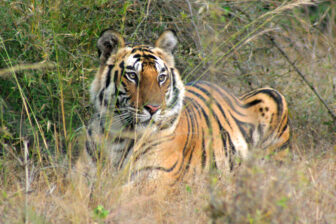Center for Large Landscape Conservation
NEWS RELEASE
FOR IMMEDIATE RELEASE
Center for Large Landscape Conservation Completes 14-month, USAID-funded Project to Advance Wildlife-Friendly Linear Infrastructure in Asia
BOZEMAN, MT, October 25, 2021 – Asia is home to many iconic wildlife species—such as Asian elephants, Bengal tigers, and Sumatran orangutans—along with some of the world’s richest biodiversity and most complex ecosystems. Yet, as Asia experiences unprecedented economic growth, the region’s natural heritage is threatened by the rapid expansion of linear infrastructure like roads, railways, and power lines. That’s why, over the last 14 months, the nonprofit Center for Large Landscape Conservation has helped USAID build a knowledge base to support Asian countries in planning wildlife-friendly linear infrastructure.
In 2020, the U.S. Agency for International Development (USAID) launched their Linear Infrastructure Safeguards in Asia (LISA) Project—an assessment of the capacity of 28 Asian countries to develop wildlife-friendly linear infrastructure. Due to the Center for Large Landscape Conservation’s expertise in this area of conservation, including road ecology, the Center was selected to be lead investigator on this project through a USAID contract* with Perez, APC. The project is now complete with the release of several reports and the conclusion of 10+ hours of webinars for constituent groups in Asia.

“Biodiversity is critical for the Earth’s life support systems to keep carbon stocks in place, provide resilience to climate change, and prevent zoonotic disease spillover. But as Asian countries continue to expand their linear infrastructure, this new development is becoming increasingly closer to natural areas with high biodiversity,” explains Dr. Mary Melnyk, Division Chief for Environmental Security and Resilience at USAID’s Asia Bureau.
“The LISA Project sought to determine where and how infrastructure and biodiversity meet and how we can protect native wildlife. We see this not as an ‘either-or’ situation but an opportunity to ensure that infrastructure and biodiversity can coexist,” says Dr. Melnyk.
The Center’s LISA Project team, with the help of 25 specialists from the U.S. and Asia, developed a Final Report summarizing the project’s key findings and recommendations. It is accompanied by four in-depth Annexes describing the results of a Capacity Assessment, Spatial Analyses, Literature Review, and Case Studies.
“As part of our effort, the Center’s spatial team mapped more than 80,000 kilometers of proposed future linear infrastructure projects across Asia. This new infrastructure could potentially impact more than 350 protected areas and 12-20 percent of Asian landscapes with the greatest biodiversity,” says Rob Ament, Senior Conservationist with the Center for Large Landscape Conservation. “This was the central objective of the project—to identify where biodiversity may suffer the most from future linear infrastructure development and to determine whether there are smart policies and knowledgeable experts to sufficiently deploy protective measures.”
Once the reports were completed, the project team synthesized the tremendous amount of information generated by the project into six virtual webinars and an accompanying Training Manual that are now available for online viewing.
“After gaining a clearer picture of what is happening on the ground in Asia, we discovered that there is much more to learn about the impacts of, and potential solutions for, linear infrastructure. Additionally, there is great need to increase expert capacity on how to design, plan, and build linear infrastructure safeguards,” says Ament. “We also found that there are many fine examples of good analysis and exemplary linear infrastructure projects to build upon.”
Hundreds of professionals from at least 18 countries attended the online trainings, representing government, industry, financing, and non-governmental organizations. They heard from a wide variety of experts based in the U.S. and Asia on topics ranging from an overview of biodiversity in Asia, to considerations for the planning and placement of safeguards like wildlife crossing overpasses.
“We view this project as the beginning, not the end, of our efforts to work with our partners to strengthen the adoption of safeguards that protect Asia’s extraordinary biodiversity,” says Dr. Melnyk.
For more information:
LISA Project Fact Sheet
LISA Project Highlights By the Numbers
LISA Project Webpage that houses all reports and the Training Module recordings
About the Center for Large Landscape Conservation
The Center for Large Landscape Conservation is the hub of a growing global movement to reverse fragmentation of the earth’s large landscapes and restore nature’s resilience to climate change. The Center works to connect natural areas, provide critical wildlife habitat and safe migration for wide-ranging animals, and protect ecological processes and systems. They accomplish this by developing science, crafting policy, and sharing expertise with partners, practitioners, and local communities around the world. Largelandscapes.org
About USAID
USAID (U.S. Agency for International Development) is the world’s premier international development agency and a catalytic actor driving development results. USAID’s work advances U.S. national security and economic prosperity, demonstrates American generosity, and promotes a path to recipient self-reliance and resilience. USAID.gov
*USAID WORLDWIDE IDIQ CONTRACT NO: AID-OAA-I-15-00051
TASK ORDER NO: AID-OAA-TO-16-00028
ESS WORK ASSIGNMENT NO. 13
###
Contact:
Christine Gianas Weinheimer
Center for Large Landscape Conservation
(406) 578-1579
communications@largelandscapes.org


0 comments on “Press Release: Protecting Biodiversity in Asia through Wildlife-Friendly Linear Infrastructure”